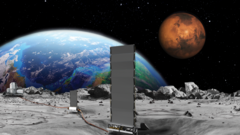NASA’s plans highlight a growing race among several nations, including the U.S., China, and Russia, to expand their presence on the Moon and establish permanent habitats. The new acting head of NASA, appointed by former President Donald Trump, emphasized that harnessing nuclear energy is crucial for both advancing lunar economy models and maintaining national security in space exploration. Proposals for developing a reactor capable of generating at least 100 kilowatts of power have been sought from commercial companies, although this output is considered minimal compared to the energy needs for a lunar base.
The concept of utilizing nuclear reactors for lunar energy isn't unprecedented. NASA previously issued contracts for reactor designs, and scientists underscore the limitations of solar power, which can be unreliable during the Moon's two-week-long nights. Experts believe that nuclear energy is crucial for supporting human life and various long-term missions on the lunar surface, with some believing it could become reality by the target date if sufficient funding is secured.
However, concerns regarding safety remain prevalent, particularly in terms of launching radioactive material. In addition, given recent budget cuts at NASA and concerns that these plans may be politically motivated, the feasibility of the 2030 timeline has come into question. The potential establishment of “keep-out zones” by Russia and China—linked to the Artemis Accords agreement—emphasizes geopolitical stakes while scientists argue that an era of competition may detract from the collaborative exploration of space.
Challenges persist, as NASA’s Artemis program aims to send astronauts to the Moon by 2027, but it faces various hurdles. As experts note, while nuclear power for potential lunar bases is essential, logistical concerns surrounding crew transport and equipment remain. The clarification of ownership and operational territories on the Moon amidst this renaissance of lunar exploration continues to provoke debate within the scientific community.
The concept of utilizing nuclear reactors for lunar energy isn't unprecedented. NASA previously issued contracts for reactor designs, and scientists underscore the limitations of solar power, which can be unreliable during the Moon's two-week-long nights. Experts believe that nuclear energy is crucial for supporting human life and various long-term missions on the lunar surface, with some believing it could become reality by the target date if sufficient funding is secured.
However, concerns regarding safety remain prevalent, particularly in terms of launching radioactive material. In addition, given recent budget cuts at NASA and concerns that these plans may be politically motivated, the feasibility of the 2030 timeline has come into question. The potential establishment of “keep-out zones” by Russia and China—linked to the Artemis Accords agreement—emphasizes geopolitical stakes while scientists argue that an era of competition may detract from the collaborative exploration of space.
Challenges persist, as NASA’s Artemis program aims to send astronauts to the Moon by 2027, but it faces various hurdles. As experts note, while nuclear power for potential lunar bases is essential, logistical concerns surrounding crew transport and equipment remain. The clarification of ownership and operational territories on the Moon amidst this renaissance of lunar exploration continues to provoke debate within the scientific community.


















